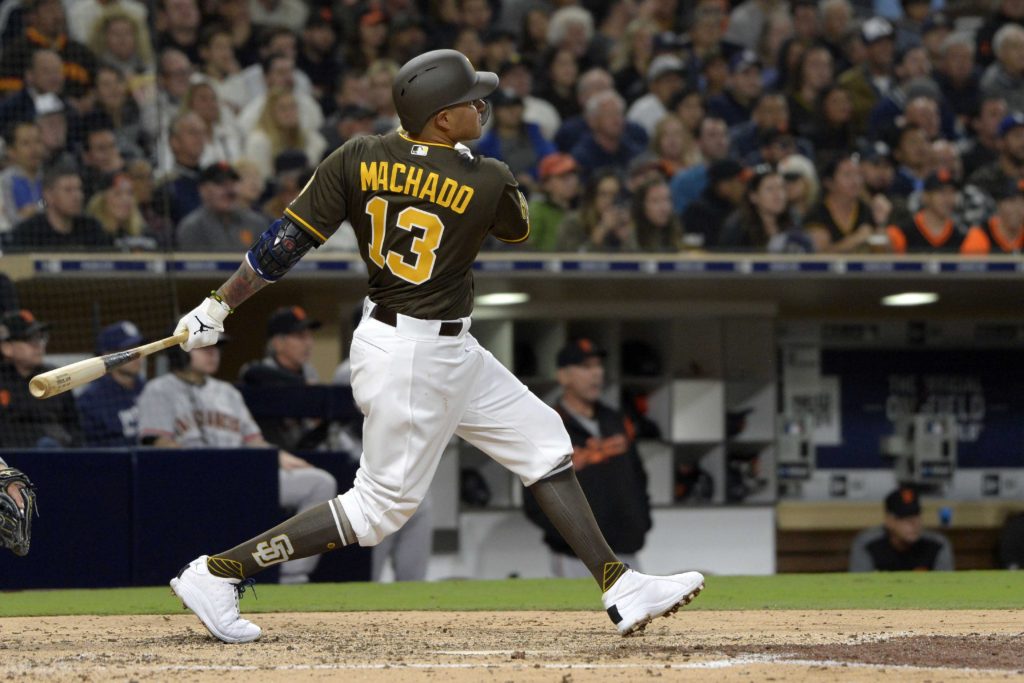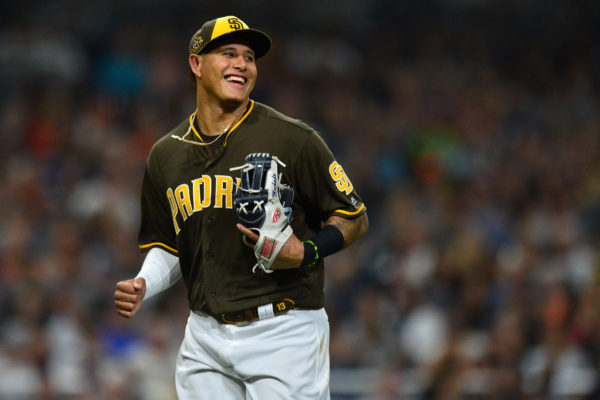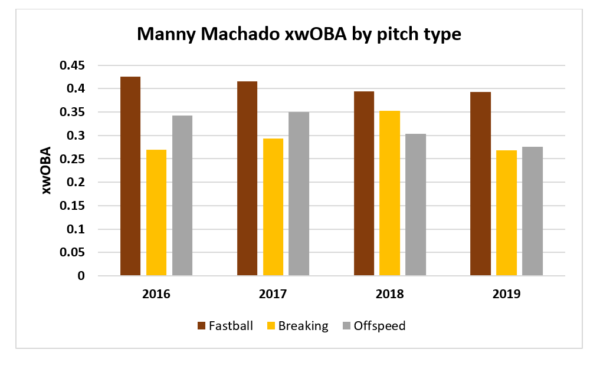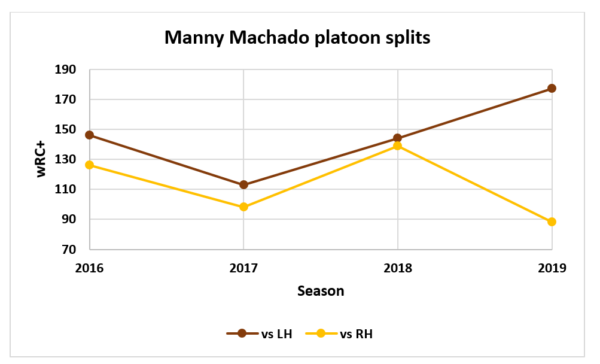Making sense of Manny Machado’s curious first season as a San Diego Padre

Mandatory Credit: Jake Roth-USA TODAY Sports

A closer look at Manny Machado’s first season in San Diego
On February 22, 2019, the San Diego Padres signed Manny Machado to what was (briefly) the largest contract in American sports history. Unfortunately, Machado’s first season as a Padre was a bit underwhelming. As the beginning of the 2020 season inches closer, Padre fans are hoping to see a significant improvement from Machado’s opening act. If 2019 was simply an aberration, then a season which your team is not contending is as good a time as any to have a down year. If he appears to be declining this early into his long contract, that is very bad news (see: Eric Hosmer). This piece will dissect what exactly went wrong for Machado in 2019, why it happened, and what we should expect in the future from the $300 million man.
Background
Machado has always hit lots of homers, and he did so again in 2019 despite moving to the pitcher-friendly Petco Park – becoming one of only four players with 30-plus homers in each of the last five seasons. However, he logged a .256/.334/.462 slash line and wasn’t the extra-base hit machine that he’s been in recent years – his 55 extra-base hits in 2019 was the fewest he’s recorded in any full season of his career by a fairly wide margin. For most of his career, Machado hasn’t been a high-OBP guy, and his on-base percentage in 2019 was almost the same as his career average of .335, which is a bit above league-average, but not particularly special. So, what changed in 2019 that caused Machado to drop to a semi-pedestrian 108 wRC+, and will he rebound in 2020?
Contact issues?
Machado posted a 19.4 percent strikeout rate in 2019, a career-high, but still better than the MLB average. On the surface, his pitch recognition didn’t appear to be any worse than usual, and the 9.8 percent walk rate was better than league-average as well. According to Fangraphs, Machado swung at pitches outside of the strike zone 31.4 percent of the time, which was the second-lowest chase rate of his career. On pitches in the strike zone, he swung 69.1 percent of the time, which was a little more than one percent better than league average but a bit lower than what he’s done the past few years (interestingly, Machado seemed to become much better at recognizing pitches in the zone in 2016 when he raised his zone swing percentage from the low/mid-60s to about 70 percent and has kept it there since). So why is he suddenly striking out more? Even though he swung at pitches outside the zone less often, his zone contact percentage and chase contact percentage were both worse than he has averaged over the last five years by a small margin. Machado’s plate discipline wasn’t the issue. He was simply missing a few more pitches when he swung the bat. This harms his overall numbers, but not nearly enough to account for the considerable drop in production he saw from 2018 to 2019. If Machado was still destroying baseballs when he made contact, this would hardly matter at all.
Batted balls and tough luck
For us to get a better idea of what Machado did last year, we’ll need to check out his batted ball statistics. This can tell us if any particular component of his offense (when he makes contact) has changed relative to his past performance, such as hitting more groundballs than usual or simply not hitting the ball as hard.

One quick way to identify if a player has run into some tough luck (or good luck) is to see if there is a large gap between their expected weighted on-base average (xwOBA) and their actual weighted on-base average (wOBA). That wasn’t the case for Machado in 2019, as his xwOBA and wOBA were very close to each other, but both were considerably lower than his 2018 numbers and five-year averages. Typically, a big drop in xwOBA occurs as a result of a change in exit velocity, launch angle, or something else that can usually be seen in a batted ball profile. Strangely, Machado’s batted ball statistics didn’t have any significant changes in 2019. As you can see, Machado continued to hit the ball hard last year. He hit the ball just about as hard, on average, as he did in 2018 and slightly harder than his overall average since 2015, when Statcast data first became publicly available. Machado’s launch angle dipped a bit from 2018, but it was nearly the same as what he’s done over the past five seasons. His distribution of ground balls, line drives, and fly balls was roughly the same as well. This means, in theory, that his xwOBA – which is based entirely on exit velocity and launch angle – should have been pretty close to what it was in 2018, but that didn’t happen. Something weird is going on here.
Alex Chamberlain of Rotographs – the fantasy baseball cohort at Fangraphs – had an interesting idea centered around barrel rate (the percentage of batted balls in which a hitter achieves optimal exit velocity and launch angle). What if a hitter has little or no control over when optimal exit velocity and optimal launch angle overlap? That is, a hitter can make lots of hard contact and carry a good average launch angle, but to achieve a “barrel” these two things have to happen at the same time (obviously) and there’s not much evidence that suggests hitters can actually control the frequency of these two things happening together. So, if this assumption is true, then a hitter could be “lucky” or “unlucky” in a given season as a result of how often these two variables coincide. Based on this premise, Chamberlain designed a metric he refers to as “deserved barrel rate” to tell us if a hitter produced more or fewer barrels than he “deserved” throughout a season. If you’re familiar with Statcast metrics, you can essentially think of this as “xBarrel%” or “expected barrel rate.” The concept is pretty straightforward: if the deserved barrel rate is larger than the actual barrel rate, the hitter was probably somewhat lucky. If the deserved barrel rate is lower than the actual barrel rate, the hitter probably experienced some bad luck.
According to Baseball Savant, Machado posted a barrel rate of 8.0 percent in 2019, compared to a deserved barrel rate of 11.1 percent. That leaves him with a 3.1 percent underperformance, the 16th largest gap in baseball among players with at least 200 batted ball events (interestingly, Francisco Mejia also underperformed his deserved barrel rate by 3.1 percent in 2019). Now we’re getting somewhere – we know that Machado was making slightly less contact in 2019, and when he did make contact, he may have experienced some unfortunate batted ball luck. But we’re not done yet.
Pitch Splits
Per Baseball Savant, breaking balls and offspeed pitches accounted for 38.6 percent of the total pitches Machado saw in 2019, which is close to his career average. With that in mind, let’s look at his xwOBA by pitch type and compare it to what he’s done the past few seasons:

Machado has always crushed fastballs, and this graph tells us that he continued to do so in 2019 to almost the exact same degree that he did in 2018. What changed in 2019 was that he struggled badly with both breaking balls and offspeed pitches. This was the first year in the last four seasons that he has recorded an xwOBA of less than .300 on both breaking balls and offspeed pitches in the same season. Beyond that, he experienced some terrible batted-ball luck against non-fastball pitches, underperforming his xwOBA by .032 on breaking balls and .055(!) on offspeed pitches. The main takeaway here is that Machado hit poorly against everything other than fastballs in 2019, and on top of that, he experienced some horrible luck against those pitches. As the old saying goes: “If you hit less good and underperform your xwOBA against specific pitch types, you’re going to have a bad time against those pitches.” The oddities of Machado’s 2019 season don’t end here, though.
Platoon Splits
Machado has carried smaller platoon splits than league-average for most of his career, owning a career 125 wRC+ against lefties and a 116 wRC+ against right-handers. In 2019, though, he posted astronomical platoon splits that we have never seen from him before. Machado posted a ridiculous 177 wRC+ against left-handed pitching while logging a below-average 88 wRC+ against righties. This graph does a better job of depicting how extreme Machado’s 2019 platoon sense were in comparison to the previous four seasons:

There’s not anything beyond pure speculation that could explain these platoon splits, but it is an interesting snippet. This isn’t a definitive reason for him having a down year, but rather “here is another weird thing that happened during what was ultimately a down year.” These splits can be expected to move closer to his career average in 2020.
What’s the overall takeaway, and what should we expect from Machado in 2020?
Machado’s 2019 season was quite odd compared to the rest of his career, but he was mostly the same player that he’s been in the past. He experienced a slight dip in performance and combined that with some tough luck on batted balls, but there’s a good chance we’ll see some positive regression in 2020. He struggled badly against everything except for fastballs. Still, even if he doesn’t start hitting non-fastball pitches any better, he will probably see better results against those pitches simply because it’s hard to get that unlucky two years in a row. Machado struck out a little more in 2019 but was still better than league average in both strikeouts and walks. He still made plenty of hard contact, although his hard-hit percentage dropped by more than four percent, going from elite to simply well above average. Depending on which defensive metric you prefer, Machado’s defense graded out reasonably close to what it’s been in the past few seasons, which is average-to-slightly-below-average. The Padres didn’t sign Manny Machado for his defense, so that isn’t an issue unless he becomes a total defensive liability, and he shouldn’t have to slide over to shortstop again so long as Fernando Tatis Jr. stays healthy. ZiPS projects Machado for 3.9 fWAR in 2020, while Steamer likes him for 4.6 fWAR, both of which would be considerable improvements from last season. Machado was a well-above-average player in 2019, but the Padres didn’t pay him to be merely above-average, they paid him to be a star. The good news is that what we witnessed from Machado in 2019 is probably closer to his floor, and you can expect to see him be considerably better for the foreseeable future.
All stats used in this article are courtesy of Fangraphs unless otherwise noted.
Holden Phillips is an Occupational Exposure Scientist who also happens to write about baseball, primarily focusing on analytics. He is a huge baseball fan and fell in love with the Padres during his college years when West Coast baseball was often the only baseball on TV after 9pm in the Eastern time zone. Find his work at eastvillagetimes.com and maxsportingstudio.com.
I wasn’t a fan of the machado signing from the start. I think we severely overpaid for an average player. Manny has a lot of potential but he’s too lazy to extend himself regularly and reach it. He plays hard when he wants to which is about 20% of the time. To me, that’s unacceptable. He’s making his money regardless of his effort. So, we are getting what we paid for… an overpaid lazy player who is not disciplined at the plate and a decent fielder.
I don’t think AJ did his due diligence here. Manny was already known as a dirty player and lazy. He paid for potential and a couple decent years from a young guy. AJ gambled with a lot of Padre cash. Manny can mature still. The potential is obviously there. Whether anyone holds him accountable or he decides to be a team player and give his teammates a better effort might be seen this year. I hope so. We can have a better year on the field if everyone, including Manny, plays good sound baseball with true effort and dedication to their team. I hope everyone will establish a good tone out the gate and carry it farther into the season. Thus, setting up next year as a year to contend.
Hold yourselves and your teammates accountable Pads! Let’s put it together this year!
Machado can be a lazy player, and after Tatis went down, so did his numbers. Anyone who watched him could tell he wasn’t as interested in playing hard once Tatis got hurt and the team was out of it. While I don’t understand defensive metrics, the naked eye will tell you Machado is an elite defender. It could be however he makes every play look easy. Tatis, Machado and Hosmer are all supposed to be good glove type players but theyir focus on routine plays was horrible. I expect them all to be much better this year. Having a new coach who isn’t soft as well as his past Orioles coaches should make Machado be more focused, as well as Tatis being healthy for a full year. Machado has always been the best player on his team, and w Tatis now that player, hopefully that pushes him.
Hosmer and Tatis are markedly not good defenders.